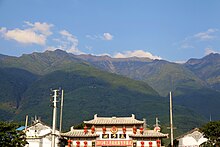
The Bai, or Pai, are an East Asian ethnic group native to the Dali Bai Autonomous Prefecture of Yunnan Province, Bijie area of Guizhou Province, and Sangzhi area of Hunan Province. They constitute one of the 56 ethnic groups officially recognized by China. They numbered 1,933,510 as of 2010.

Dali City is the county-level seat of the Dali Bai Autonomous Prefecture in northwestern Yunnan. Dali City is administered through 12 township-level districts, two of which are also commonly referred to as Dali.

The Dali Kingdom, also known as the Dali State, was a dynastic state situated in modern Yunnan province, China from 937 until 1253. In 1253, it was conquered by the Mongols but members of its former ruling house continued to administer the area as tusi chiefs under the auspices of the Yuan dynasty until the Ming conquest of Yunnan in 1382. Today the former capital of the Dali Kingdom is still called Dali in modern Yunnan Province.

Chuxiong Yi Autonomous Prefecture is an autonomous prefecture located in central Yunnan Province, China. Chuxiong has an area of 29,256 km2 (11,296 sq mi). The capital of the prefecture is Chuxiong City.

Dali Bai Autonomous Prefecture is an autonomous prefecture of northwestern Yunnan Province, People's Republic of China. Dali has an area of 29,460 square kilometres (11,370 sq mi) and its seat is located in Xiaguan, Dali City.
Bai is a Sino-Tibetan language spoken in China, primarily in Yunnan Province, by the Bai people. The language has over a million speakers and is divided into three or four main dialects. Bai syllables are always open, with a rich set of vowels and eight tones. The tones are divided into two groups with modal and non-modal phonation. There is a small amount of traditional literature written with Chinese characters, Bowen (僰文), as well as a number of recent publications printed with a recently standardized system of romanisation using the Latin alphabet.

Nanjian Yi Autonomous County is a county in the Dali Bai Autonomous Prefecture located in the west central part of Yunnan province, China.
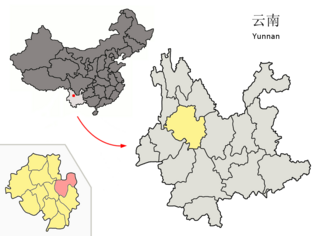
Binchuan County is a county in the Dali Bai Autonomous Prefecture located in the west of Yunnan Province, China.
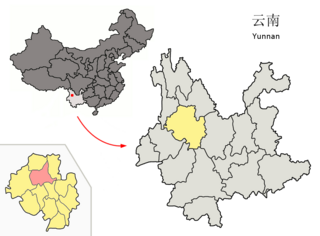
Eryuan is a county in the Dali Bai Autonomous Prefecture located in southern Yunnan Province, China.

Heqing County is a county in the Dali Bai Autonomous Prefecture located in the northwest of Yunnan Province, China.
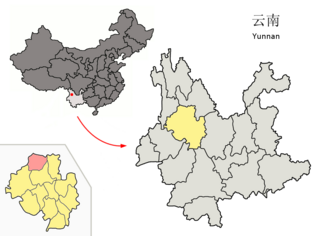
Jianchuan County, historically known as Yidu is a county in the Dali Bai Autonomous Prefecture located in the western part of Yunnan Province, China. The county is about 50 km (31 mi) southwest of Lijiang and 120 km (75 mi) north of Dali.
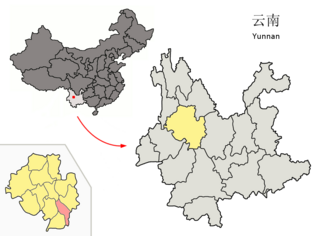
Midu County is a county in the Dali Bai Autonomous Prefecture located in west-central Yunnan province, China.

Xiangyun County is a county in the Dali Bai Autonomous Prefecture located in the west-central part of Yunnan province, China.

Yongping County is a county of the Dali Bai Autonomous Prefecture, located in the west of Yunnan Province, China.

The Qixingmin are an officially unrecognized ethnic group of western Guizhou province, China. They are officially classified as Bai by the Chinese government. The Qixingmin speak a Yi (Loloish) language known as Luoji. The Guizhou Province Ethnic Gazeteer (2002:692) reports that, in 1982, there were about 700 speakers among the more easterly Qixingmin.

Five Golden Flowers is a 1959 Chinese romantic musical film directed by Wang Jiayi and produced by Changchun Film Studio. The screenplay was written by Zhao Jikang and Wang Gongpu. Set in the Dali City in Yunnan Province, the film is about a Bai ethnic youth, Ah Peng, searching for his beloved ethnic girl Jin Hua. Made during the Great Leap Forward, the film celebrates socialist construction and agricultural collectivization. The theme song of the film "By the Butterfly Spring," composed by musician Lei Zhenbang, was one of the most well-known folk songs in China. The film was produced and released in 1959. It received exuberant responses from audiences and was exported to 46 countries after its debut. During the Cultural Revolution, it was banned and attacked by Jiang Qing for promoting romanticism. In 1978, the film was re-released. At the Second Asian-African Film Festival in Cairo in 1960, the film won the best director and best actress awards. In the 2000 Changchun Film Festival, Five Golden Flowers won first place in the "Top 10 Chinese Films of the Century" selection.
Dali University is a provincial public university located in Dali Bai Autonomous Prefecture, Yunnan, China. The university is affiliated with the Yunnan Provincial People's Government.

Xizhou is a town located 20 km (12 mi) north of Dali Old Town in Dali City, part of the Dali Bai Autonomous Prefecture in northwestern Yunnan, China. The town consists of 13 small villages with a combined population estimated at 54,779, mostly consisting of Bai people with a small population of Hui and Han residents. Xizhou is located about 1 km (0.62 mi) from the shores of Erhai Lake to the east, and 2 km (1.2 mi) to the Cang Mountain to the west. Xizhou has been historically important as a trading post along the Tea Horse Road, it was once home to a landing strip and radio station for the Flying Tigers during WWII, has been home to notable rulers and governors of local polities past and present, and has gained notoriety in modernity for its high concentration of preserved and restored traditional Bai architecture and protected heritage sites.

Shangguan Town is a town under the administration of Dali City, Dali Bai Autonomous Prefecture, Yunnan, China.
